


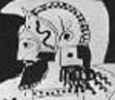

7th century BC
650-600 BC
550-520 BC
470 BC
450 BC
|
"Hercules:
Tell me, Salmoneus, do I look like there's anything
wrong with me?" (H:TLJ ep.11)
|
| There was a great deal of talk about Sorbo's long-haired Herc. Well-known Herculeses from the old movies all have short hair-style. Shall we try to find out which portraing is accurate? |
| Almost all the time when we have possibility to estimate his hairdo, Herakles is depicted with short hair. But nearly the half of his representations from Archaic and Classical periods show him with the lion's skin draped around his shoulders and the head of the lion pulled forward over Herakles' own head as a hood, so we can have only guesses. |
|
In the Odyssey (I, 90) Athena says she want to set courage in Telemachus' heart "to call to an assembly the long-haired Achaeans." Long hair were used to distinguish competent to make decisions, in some time period that is to tell free citizens from slaves, in another - aristocrats from common people. As the member of royal family Herakles could be shown with long hair, but as slave of Eurystheus he could have haircut. |
 |
 |
 |
 |
 |
|
Odysseus
7th century BC |
Herakles
650-600 BC |
Eurystheus
550-520 BC |
Ajax The Lesser
470 BC |
Menelaos
450 BC |
| "His look is not so Herculean. It isn't Sorbo's fault, but a sinewy BLOND Hercules with a surfer's tan?" (Arion Berger in LA Weekly - 31.05.96) |
|
Conception of ethnic type of ancient Greeks as persons with jet-black hair unfortunately is widespread mistake. Many gods (including Apollo, Aphrodite and Eros) and heroes (Meleager, Menelaos, Achilles, Odysseus and others) according to mytho-epic tradition were light haired. Ancient authors were using words that stand for "colour of fire", "colour of sand" and "colour of gold". In translations sometimes the same passage may have two versions. For example, "fair hair" or "yellow hair" of the hero Achilles in Iliad (I, 197). |
|
Euripides in "Herakles": "First Herakles cleared the grove of Zeus of a lion, and put its skin upon his back, hiding his yellow [or "auburn"] hair in its fearful tawny gaping jaws." |
 |
 |
 |
 |
 |
|
Herakles
550-500 BC |
Herakles
550 BC |
Herakles
560-530 BC |
Herakles
530-520 BC |
Herakles
525 BC |
 |
The old Black Figure style of vase painting easily allowed to show light hair, but an entirely new Red Figure technique (invented around 530 BC) make it difficult. Though some painters were able to find the way to do it. This is my favorite - blond baby Herakles strangling snakes left and his dark-haired brother Iphikles right, 480-470 BC. |
|
"If you watch weekend t.v., you still might not recognize this hero. Hercules (Heracles) was usually depicted bearded. The beard was a sign that he was a full adult: he had a wife and kids." (Lecturer Greta Ham, Department of Classics, The University of Texas at Austin, on her professional web-page (now gone) - 01.98) |
| It will be safe to say that in most cases Herakles really was represented bearded, but there is no problem to find his effigy without beard. The images below show him in the events after he became husband and father. |
 |
 |
 |
 |
 |
|
|
Battling Kyknos
520-510 BC |
|
Catching Cerberus
510 BC |
Capturing Troy
490-475 BC |
Killing Nessus
475-425 BC |
With Hesperides
420-400 BC |
| "His look is not so Herculean. This Herc is a boy, so far from the manly, lion-pelt-brandishing demi-god on display at the Getty museum - now THAT'S Hercules - you wonder if the creators were deliberately going for a non-Classic Greek look on top of clearly trying to appeal to kids with a hero closer in age to it's target audience." (Arion Berger in LA Weekly - 31.05.96) | |
|
Doubtless, Kevin imparted
a boyish charm to Herc that is certainly missing from those old paintings
and statues! But I'm sure that this portrayal is just making Herakles
alive (and appealing not only to kids, if you know what I mean).
|
|
| "Kevin Sorbo has grown into the lead role despite being less beefy than one might expect from the strongest man in the world." (Welton Jones in San Diego Union Tribune - 15.10.96) | |
| Well, Herakles was most commonly portrayed in the art of Ancient Greece as a muscular grown man, none the less artists seem to be aware of the source Herakles owed his strength to. He was son of Zeus, for Olympus sake! Why must he look like the biggest bodybuilder? | |
|
|
Even when dealing with representations of the hero made by someone who wanted to emphasize his might, we see not enormously huge man, but a person with unnaturally big thighs (ancient equivalent to present-day large chest and arms), though it is better to remember that other heroes and some gods were shown in the same manner. Herakles 530 BC |
 |
Only in the Late Classical Period was developed the tendency to show Herakles as a walking muscular mass. Too well-known The Farnese Hercules is a good example of such ponderous, unpleasantly swollen hero. The Herakles Farnese - Roman marble copy of a lost Greek statue, probably by Lysippos or one of his followers (350-300 BC). |
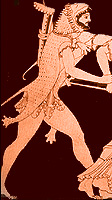 |
 |
 |
 |
 |
|
Herakles
500-480 BC |
Herakles
500 BC |
Herakles
470-457 BC |
Herakles
circa 340 BC |
Herc
1998 |
| In the great amount of texts dedicated to the Greek history-mythology we can meet phrases like "Herakles always wears a lion's skin" or "The cloak from the lion's pelt he wore always identified Heracles in the classical art, with the hood over his head". But no single word about vest and leather pants. Shall we continue our investigation? |
|
In the Geometric Period, artists did not characterize Herakles by attributes (i.e. he was not shown with his club or lion skin), but in the mid Archaic period iconography of Herakles underwent a slow transformation. As far as I can see, at first he was depicted dressed in a short chiton (A) or wearing nothing at all (B), then he was shown in the skin of the Nemean Lion over chiton, pulled snugly around his body and secured with a belt; the forepaws knotted at the throat and the head worn like a hood (C), not much later he was represented in the lion skin over naked body (D) and wearing chiton with a suit of armour (E). Variants B and C were the most popular in the art of Ancient Greece. |
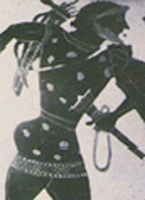 |
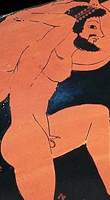 |
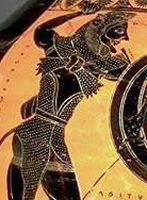 |
 |
 |
|
A - Herakles |
B - Herakles
530-520 BC |
C - Herakles
550-540 BC |
D - Herakles
490-470 BC |
E - Herakles
530-520 BC |
|
"Kevin Sorbo is grateful that the ridiculous woven leather trousers were designed not with regard for historical or mythological accuracy, but for comfort and style." (10.95 Sci-Fi Universe #10) Pants are considered to appear in the nomad groups as an article of clothing essential to riding. Ancient Greeks didn't wear any type of trousers because they were not horsemen, they used only chariots. So, we have found the greatest breach of manners... But what do you want? Sure, a lot of female fans would be glad to watch him in the B or D model, however no TV channel can allow this to happen. Model C or E would keep happy purists, but no actor can survive in the jaws of lion or armour for 6 years. And for the clearance sale we have only model A, bearing too much similarity to the *togas* from old movies. Similarity, which creators of H:TLJ tried to avoid with all their might. (Not to mention banal reason called New Zealand weather - with the temperature +10-+15C one may want to have something but linen chiton to defence his body from being cold.) |
 |
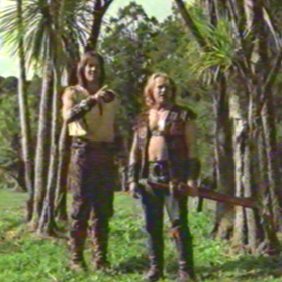 |
"With its lush rain forests, towering cliffs and vast expanses of green, New Zealand is hardly a dead ringer for ancient Greece. But the lack of olive trees doesn't bother Tapert in the slightest." (Dan Vebber in Sci-Fi Universe #10 - 10.95) |
|
"The change of vegetation in the Mediterranean area has taken place basically under the effect of the human activities. In conditions of the Mediterranean climate where the warm season is not provided with a moisture, renewal of the woods goes with difficulty, and at long systematic fellings and fires they were replaced by bushy thickets." (A.Graziansky "Mediterranean Nature", 1971 - in my translation) |
|
|
"By the middle of the first millennium B.C. the shape of many territories of the Mediterranean area substantially changed as a result of hewing out forests, erosion and destruction of top-soil." (R.Balandin, L.Bondarev "Nature and Civilization", 1988 - in my translation) |
|
| "There, where are now rocky mountains, earlier were seen the beautiful hills, covered with soil, the so-called stone plateaus were once fertile arable lands; and mountains were covered with dense forests, from which to our time the traces still remain. There are mountains in the Attica, on which only bees can find the food for themselves now, but not too long ago on them grew splendid trees of which it was possible to make roofs for the largest buildings; the roofs, made from this wood, stand and until now. Annual rainfall was not lost as nowadays, when the water is allowed to flow down on the devastated ground in the sea, rains were absorbed by the ground covered with luxuriant vegetation." (Plato "Critias" - in my translation from Russian) | |
Official graphics ® MCA TV, Universal
® 2003 KSJAA - Please, don't borrow contents without permission.